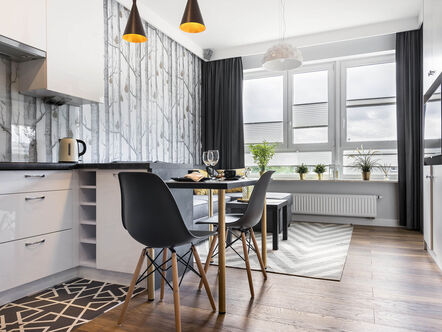If a property is to be let to multiple occupiers who are not a family unit, the local authorities may class it as an HMO. This type of rental property can be an excellent investment opportunity but they are subject to additional regulation, licensing and inspections for the safety of the occupants.
What is an HMO?
A rented property is considered a House in Multiple Occupation if it is occupied by three or more people who share facilities such as the kitchen or bathroom, who form two or more 'households'. It’s sometimes called a ‘house share’. We also recommend that you seek guidance from your local authority about what they consider to be an HMO.
What is meant by the term 'Household'?
A household is either a single person or members of the same family who live together. A family includes people who are:
- married or living together (including same-sex couples)
- relatives or half-relatives (e.g. grandparents, aunts, uncles, siblings)
- step-parents and step-children
- foster parents and foster children
What are the benefits of letting my property as an HMO?
As with any property investment, landlords need to consider the advantages and disadvantages, but there are some clear benefits that HMO investment can bring if done right:
- HMOs can produce much higher rental yields than traditional rental properties
- Demand for shared living accommodation is usually robust, due to tenants seeking affordable accommodation
- When one tenant moves out, you still have several others paying rent while you find a replacement for the vacant room, so the impact of voids is reduced
Whilst the benefits are numerous, more tenants in one property means more tenancy agreements, check-ins and check-outs - and the nature of a house-share may mean that tenants may be likely to move-on more frequently. This all means that HMOs can require more hands-on management than other rental properties, although a good letting agent will help you deal with this.
HMO’s are also subject to additional regulation and may require a licence.
When does an HMO require a licence?
If you want to rent out your property as an HMO in England or Wales you should contact your council to check if you need a licence. You must have a licence if all of the following apply to your property:
- It is rented to 5 or more people who form more than 1 household
- Some or all tenants share toilet, bathroom or kitchen facilities
In this instance, your property would be classed as a “large HMO” and would require mandatory licensing. However, councils can bring in additional licensing requiring all HMOs to be licensed, so even if your property is not considered a “large HMO”, you may still need a licence depending on the area. Contact your local authority to confirm whether you need a HMO licence.
Once granted the licence must be clearly displayed within the communal areas along with the name, address and telephone number of the licensee or property manager of the premises. A copy of the current gas safety certificate must also be on display.
What happens if I don’t apply for a licence?
It is a criminal offence to operate a HMO which requires a license without one. If a landlord is convicted, the fines for non-compliance are unlimited. Local authorities also have the power to vary the terms of a granted HMO licence or to revoke an HMO licence.
Landlords may receive a rent repayment order and have to pay back to a tenant any rent they have received, or pay back any housing benefit received to the council, up to a maximum 12 months.
What are my responsibilities if I let my property as an HMO?
As well as all your normal legal responsibilities as a landlord you must ensure:
- the house is suitable for the number of occupants (this depends on its size and facilities)
- the manager of the house - you or an agent - is considered to be ‘fit and proper’, for example they have no criminal record or breach of landlord laws or code of practice
- send the council an updated gas safety certificate every year
- install and maintain smoke alarms
- provide safety certificates for all electrical appliances when requested
- smoke detectors are installed
- there are adequate cooking and washing facilities
- communal areas and shared facilities are clean and in good repair
- there are appropriate refuse storage and disposal facilities
Minimum sleeping room sizes for HMOs
The minimum standards applicable nationwide are:
- 4.64 m² for one child under 10 years of age
- 6.51 m² for one person over 10 years of age
- 10.22 m² for two people over 10 years of age
Any part of a room where the ceiling height is less than 1.5m is not considered as usable floor space. Your local authority may also apply larger room size standards, but cannot set a standard lower than these nationwide standards.
How many bathrooms should an HMO have?
Many HMO rooms come with en-suite facilities. However, the minimum requirements of Health and Safety Legislation is at least one bathroom for every four tenants, and a minimum of one for every 3 tenants is widely considered best practice. Remember that a happy and satisfied tenant is likely to want to stay longer, so it’s best to avoid queues for the bathroom and any associated arguments!
HMO mortgages
HMO mortgages differ from standard buy-to-let mortgages in that they allow the letting of multiple rooms to multiple people, which normal buy-to-let mortgages don’t allow.
There are several different kinds of HMO mortgage available and the one you need will depend on which stage the HMO property is at:
- Mortgages or re-mortgages for new and existing HMOs
- Development loans for building and construction work
- Refurbishment loans
Planning permission & Article 4
Different types of dwelling are categorised into planning classes:
- C3 - standard residential family home
- C4 - small HMOs housing between three and six people
- Sui Generis - large HMOs of seven people or more
To move in and out of the Sui Generis class, you’ll always need planning permission, so any HMO with seven or more people living in it will require planning permission regardless of location.
Moving between C3 and C4 class falls under permitted development, so in most cases, a small C4 HMO won’t require planning permission, unless there is a planning condition on the property restricting its use. However, in an Article 4 area, planning permission is required to convert a C3 single dwelling property into a small C4 class HMO.
Article 4 is a special planning regulation introduced by local planning authorities to provide additional powers over development in a particular location, for example if they wish to protect the character of the local area. These regulations remove permitted development rights for certain minor alterations, extensions and changes of use.
Article 4 is usually introduced because of the density of HMOs that already exist in the area, so it is important to know the rules in your area if you are thinking of buying a property to let out as an HMO.
HMO council tax rules
In HMOs where each room is let out on an individual tenancy, the landlord is responsible for paying council tax on the property as a whole. Rent charged in an HMO usually includes utility bills and reflects some contribution towards council tax.
Furnishing an HMO
The standard requirements for any HMO include a 4ft or double bed, a double wardrobe, a chest of drawers and a bedside table. Divan beds can offer extra storage space and landlords often include desks as well, as this allows people to work from home, or use a computer.
It is possible to furnish an HMO without breaking the bank, but good quality is as important as price if you’re looking to attract professional tenants. Decoration should be to a professional finish and ideally furniture should complement the décor.
The landlord is expected to furnish the communal kitchen and lounge or dining area, as well as the individual bedrooms. Kitchen items provided usually include a fridge/freezer, storage area, washing machine, oven and hob, tumble dryer and microwave oven. Items should be suitable for the number of tenants sharing them, so in bigger HMOs you sometimes find multiple ovens, hobs, fridges and washing machines.
Standard expected furnishings in the living area normally include a dining table and chairs, sofa, TV and storage space. The HMO market can be competitive, so you want your property to look as appealing as possible.
Unlike single-let rental properties, where the tenant is responsible for any damage to the furnishings, in an HMO, the landlord is responsible for dealing with any damage to items of furniture in communal areas of the property. However, this doesn’t apply to furnishings provided in the tenants’ individual rooms, or to the tenants’ own possessions.
General wear and tear is classed as an expected part of everyday use. Damage is unfortunately more likely due to the number of people living there and it is the landlord’s responsibility to replace any items that become unusable due to general wear and tear.
Paying for repairs and damage caused by tenants in communal areas is one of the pitfalls of HMOs. However, the higher return on investment that most HMOs provide make up for this issue.



